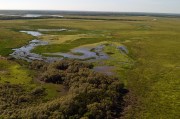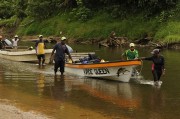Determining strategies to protect or restore flow regimes to achieve ecological outcomes is a focus of water policy and legislation in many parts of the world. A team from Queensland DNRM has developed a risk-based ecohydrological approach that links ecosystem values to desired ecological outcomes. This allows the relative risk from different flow management scenarios to be evaluated at relevant spatial-scales and a robust and useful foundation upon which to build the information needed to support water planning decisions. A case study using the eastern long-necked turtle is presented, with input from IAE staff and former students.

Abstract
For several decades there has been recognition that water resource development alters river flow regimes and impacts ecosystem values. Determining strategies to protect or restore flow regimes to achieve ecological outcomes is a focus of water policy and legislation in many parts of the world. However, consideration of existing environmental flow assessment approaches for application in Queensland identified deficiencies precluding their adoption. Firstly, in managing flows and using ecosystem condition as an indicator of effectiveness, many approaches ignore the fact that river ecosystems are subjected to threatening processes other than flow regime alteration. Secondly, many focus on providing flows for responses without considering how often they are necessary to sustain ecological values in the long-term. Finally, few consider requirements at spatial-scales relevant to the desired outcomes, with frequent focus on individual places rather than the regions supporting sustainability. Consequently, we developed a risk-based ecohydrological approach that identifies ecosystem values linked to desired ecological outcomes, is sensitive to flow alteration and uses indicators of broader ecosystem requirements. Monitoring and research is undertaken to quantify flow-dependencies and ecological modelling is used to quantify flow-related ecological responses over an historical flow period. The relative risk from different flow management scenarios can be evaluated at relevant spatial-scales. This overcomes the deficiencies identified above and provides a robust and useful foundation upon which to build the information needed to support water planning decisions. Application of the risk assessment approach is illustrated here by two case studies.
The full paper can be downloaded as a pdf.








































